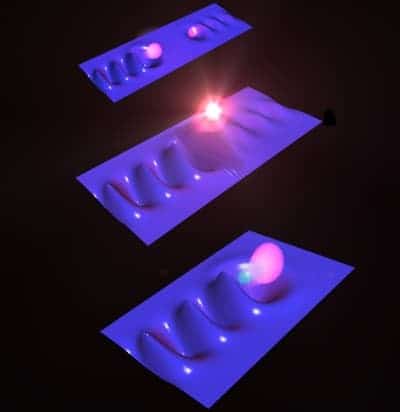A physicist's fantasy of owning a "tabletop" particle accelerator has been brought one step closer to reality according to research done in France. The accelerator uses two laser pulses to drive an electric field, thus producing monoenergetic electron energies of up to 250 MeV. But unlike previous attempts, the electron beams are stable enough to have practical applications in areas such as radiotherapy and radiography (Nature 444 737).

High-energy particles are mostly produced in vast conventional accelerators such as the 6.3-km-circumference Tevatron in the US. But while these costly edifices have undoubtedly led to many discoveries, physicists would like to find smaller and cheaper ways to accelerate particles. That is why some researchers have been trying to construct accelerators based on “plasma wakefields” that could be compact enough to literally fit on a table.
Typically a short, intense laser pulse is fired at a jet of gas, producing a plasma of electrons and ions. As the pulse travels through the plasma, it drags nearby electrons away from their positive nucleons, thus creating a large electric field in its wake (hence the term “wakefield”). This wakefield has a huge accelerating potential of up to 270 GVm-1 – over 5000 times that of conventional accelerators.
In recent attempts to make compact accelerators, physicists have relied on the density of displaced electrons to increase so much that some of them fall back into the wakefield so that they are accelerated to high energies. However, these “self-injected” electron beams have proved notoriously hard to control.
Victor Malka and colleagues at the École Polytechnique in Palaiseau have solved this issue by introducing a second laser pulse to inject the electrons. When this laser pulse collides with the first in the plasma, the interference also creates a standing wave that pre-accelerates electrons before they enter the wakefield. Remarkably, this method of using “background” electrons produces an electron beam with energy up to 250 MeV in just over 2 mm, and its precise energy can be tuned by altering the point of the laser pulses’ collision in the gas jet.
Karl Krushelnick, an expert on plasma wakefield accelerators, heralds this as an important breakthrough: “Although there has been experimental work in the past, this is the first successful experiment,” he told Physics Web. “However, it will remain to be seen whether the two [pulses] will be necessary to get good control over all the electron beam parameters.”


